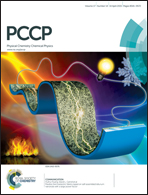Hierarchical multi-scale simulations of adhesion at polymer–metal interfaces: dry and wet conditions†
Abstract
We performed hierarchical multi-scale simulations to study the adhesion properties of various epoxy–aluminium interfaces in the absence and presence of water. The epoxies studied differ from each other in their hexagonal ring structures where one contains aromatic and the other aliphatic rings. As aluminium is unavoidably covered with alumina, a cross-linked epoxy structure near an alumina substrate is created and relaxed by performing coarse-grained simulations. To that purpose, we employ a recently developed parameterization method for variable bead sizes. For polymer–metal interactions, a multi-scale parameterization scheme is applied where the relative adsorption of each bead type is quantified. At the mesoscopic scale, the adhesion properties of different epoxy systems are discussed in terms of their interfacial structure and adsorption behavior. To further perform all-atom simulations, the mesoscopic structures are transformed into atomistic coordinates by applying a reverse-mapping procedure. Interface internal energies are quantified and the simulation results observed at different scales are compared with each other as well as with the available experimental data. The good agreement between observations from simulations and experiments shows the usefulness of such an approach to better understand polymer–metal oxide adhesion.


 Please wait while we load your content...
Please wait while we load your content...